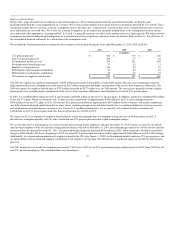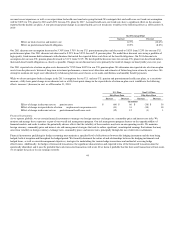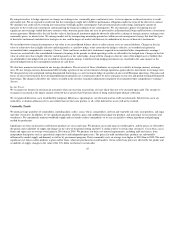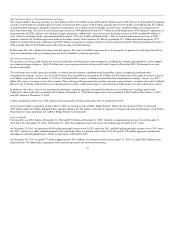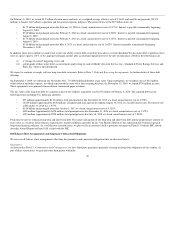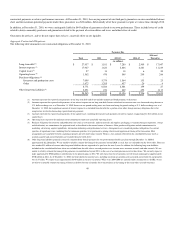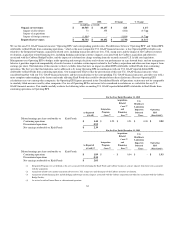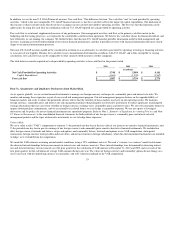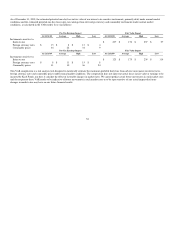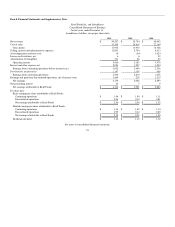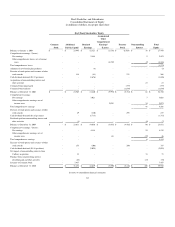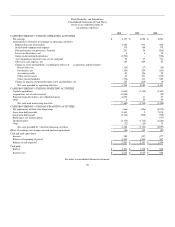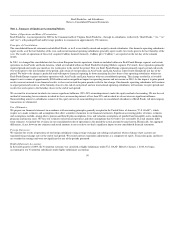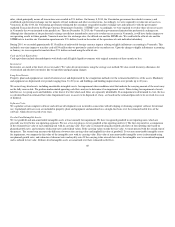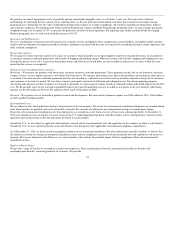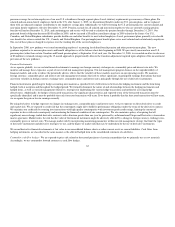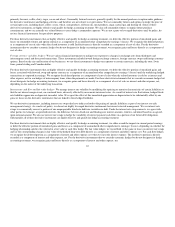Kraft 2010 Annual Report Download - page 56
Download and view the complete annual report
Please find page 56 of the 2010 Kraft annual report below. You can navigate through the pages in the report by either clicking on the pages listed below, or by using the keyword search tool below to find specific information within the annual report.
In addition, we use the non-U.S. GAAP financial measure "free cash flow." The difference between "free cash flow" and "net cash provided by operating
activities," which is the most comparable U.S. GAAP financial measure, is that free cash flow reflects the impact of capital expenditures. The limitation of
this measure is that it includes items that do not have an impact on our cash flow provided by operating activities. The best way that this limitation can be
addressed is by using free cash flow in combination with our U.S. GAAP reported net cash provided by operating activities.
Free cash flow is an internal, supplemental measure of our performance. Our management uses free cash flow as the primary cash flow metric in the
budgeting and forecasting processes, as it represents the controllable cash flows from operations. We believe free cash flow shows the financial health of, and
how efficiently we are running, the company. We further believe that this non-U.S. GAAP measure provides information useful to both management and
investors in gaining an overall understanding of our current financial performance, and that it provides investors with financial information that most closely
aligns to our internal measurement processes.
This non-U.S. GAAP measure should not be considered in isolation or as an alternative to cash flows generated by operating, investing or financing activities
as a measure of our liquidity. Because free cash flow is not a measurement determined in accordance with U.S. GAAP, and is thus susceptible to varying
calculations, free cash flow may not be comparable to other similarly titled measures of other companies.
The table below reconciles reported net cash provided by operating activities to free cash flow for the periods stated.
2010 2009 2008
(in millions)
Net Cash Provided by Operating Activities $ 3,748 $ 5,084 $ 4,141
Capital Expenditures (1,661) (1,330) (1,367)
Free cash flow $ 2,087 $ 3,754 $ 2,774
Item 7A. Quantitative and Qualitative Disclosures about Market Risk.
As we operate globally, we use certain financial instruments to manage our foreign currency exchange rate, commodity price and interest rate risks. We
monitor and manage these exposures as part of our overall risk management program. Our risk management program focuses on the unpredictability of
financial markets and seeks to reduce the potentially adverse effects that the volatility of these markets may have on our operating results. We maintain
foreign currency, commodity price and interest rate risk management policies that principally use derivative instruments to reduce significant, unanticipated
earnings fluctuations that may arise from volatility in foreign currency exchange rates, commodity prices and interest rates. We also sell commodity futures to
unprice future purchase commitments, and we occasionally use related futures to cross-hedge a commodity exposure. We are not a party to leveraged
derivatives and, by policy, do not use financial instruments for speculative purposes. Refer to Note 1, Summary of Significant Accounting Policies, and Note
12, Financial Instruments, to the consolidated financial statements for further details of our foreign currency, commodity price and interest rate risk
management policies and the types of derivative instruments we use to hedge those exposures.
Value at Risk:
We use a value at risk ("VAR") computation to estimate: 1) the potential one-day loss in the fair value of our interest rate-sensitive financial instruments; and
2) the potential one-day loss in pre-tax earnings of our foreign currency and commodity price-sensitive derivative financial instruments. We included our
debt; foreign currency forwards and futures, swaps and options; and commodity futures, forwards and options in our VAR computation. Anticipated
transactions, foreign currency trade payables and receivables, and net investments in foreign subsidiaries, which the abovementioned instruments are intended
to hedge, were excluded from the computation.
We made the VAR estimates assuming normal market conditions, using a 95% confidence interval. We used a "variance / co-variance" model to determine
the observed interrelationships between movements in interest rates and various currencies. These interrelationships were determined by observing interest
rate and forward currency rate movements over the prior quarter for the calculation of VAR amounts at December 31, 2010 and 2009, and over each of the
four prior quarters for the calculation of average VAR amounts during each year. The values of foreign currency and commodity options do not change on a
one-to-one basis with the underlying currency or commodity, and were valued accordingly in the VAR computation.
53


